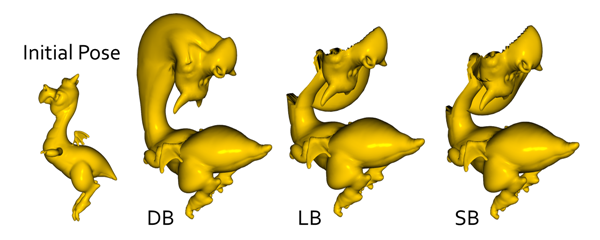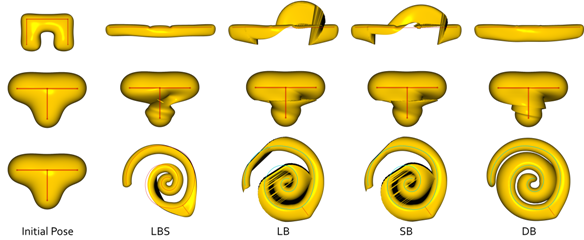Differential Blending for Expressive Sketch-Based Posing
A. C. Oztireli, I. Baran, T. Popa, B. Dalstein, R. W. Sumner, M. GrossProceedings of the 2013 ACM SIGGRAPH/Eurographics Symposium on Computer Animation (Anaheim, USA, July 19-21, 2013), pp. 155-164
Abstract
Generating highly expressive and caricatured poses can be difficult in 3D computer animation because artists must interact with characters indirectly through complex character rigs. Furthermore, since caricatured poses often involve large bends and twists, artifacts arise with traditional skinning algorithms that are not designed to blend large, disparate rotations and cannot represent extremely large rotations. To overcome these problems, we introduce a differential blending algorithm that can successfully encode and blend large transformations, overcoming the inherent limitation of previous skeletal representations. Based on this blending method, we illustrate a sketch-based interface that supports curved bones and implements the line-of-action concept from hand-drawn animation to create expressive poses in 3D animation. By interpolating stored differential transformations across temporal keyframes, our system also generates caricatured animation. We present a detailed technical analysis of our differential blending algorithm and show several posing and animation results created using our system to demonstrate the utility of our method in practice.Overview
Caricatured poses and expressive movement are the hallmark of hand-drawn animation, where pencil and paper afford the artist full creative freedom when crafting the shape and movement of animated characters. In three-dimensional animation, however, highly expressive and caricatured poses are more difficult to achieve, since the artist interacts with the character indirectly via the character's rigging controls. In order to accommodate a wider range of expressiveness, character rigs become more and more complex, making them even harder to control. Even with this complexity, some poses are still not achievable, since the technical components of the rigging system are not designed to support them. As a result, expressive poses that come naturally from the fluid interaction of paper and pencil can be cumbersome or impossible to achieve using modern 3D animation tools. Our research addresses these shortcomings in 3D animation by proposing a novel blending method for skeletal deformations and illustrating how it can be used to transfer concepts from 2D hand-drawn animation to 3D character animation.
The core technical challenge of developing such a system lies in blending skeletal transformations. Because highly expressive poses involve large bends and twists, the rigging system is forced to blend large, disparate rotations in complex regions such as the shoulder where vertices are influenced by multiple portions of the skeleton. Due to ambiguities inherent in the representation of rotations, blending algorithms used by existing rigging systems fail to give smooth and intuitive results. To solve these problems, we propose a new blending technique specifically designed for large and disparate transformations, as our main contribution.
Our differential blending method represents all transformations in a differential manner and computes averages of the differential transformations, which are then composed to get the final blended transformation. Since averaging is used to combine only small transformations, geodesic averaging always gives the correct result and the artifacts that arise from blending disparate transformations or ones that are too large to be represented correctly are avoided. By interpolating the differential transformations between animation keyframes, our system naturally extends to animated deformations. We provide a detailed analysis of our new differential blending algorithm and show that it results in smooth and intuitive skeletal deformations.
Results







